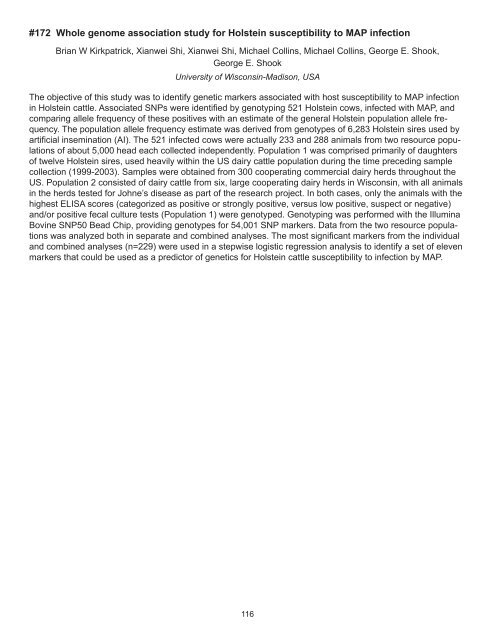Proceedings of the 10th International Colloquium on Paratuberculosis
Proceedings of the 10th International Colloquium on Paratuberculosis
Proceedings of the 10th International Colloquium on Paratuberculosis
You also want an ePaper? Increase the reach of your titles
YUMPU automatically turns print PDFs into web optimized ePapers that Google loves.
#172 Whole genome associati<strong>on</strong> study for Holstein susceptibility to MAP infecti<strong>on</strong><br />
Brian W Kirkpatrick, Xianwei Shi, Xianwei Shi, Michael Collins, Michael Collins, George E. Shook,<br />
George E. Shook<br />
University <str<strong>on</strong>g>of</str<strong>on</strong>g> Wisc<strong>on</strong>sin-Madis<strong>on</strong>, USA<br />
The objective <str<strong>on</strong>g>of</str<strong>on</strong>g> this study was to identify genetic markers associated with host susceptibility to MAP infecti<strong>on</strong><br />
in Holstein cattle. Associated SNPs were identified by genotyping 521 Holstein cows, infected with MAP, and<br />
comparing allele frequency <str<strong>on</strong>g>of</str<strong>on</strong>g> <str<strong>on</strong>g>the</str<strong>on</strong>g>se positives with an estimate <str<strong>on</strong>g>of</str<strong>on</strong>g> <str<strong>on</strong>g>the</str<strong>on</strong>g> general Holstein populati<strong>on</strong> allele frequency.<br />
The populati<strong>on</strong> allele frequency estimate was derived from genotypes <str<strong>on</strong>g>of</str<strong>on</strong>g> 6,283 Holstein sires used by<br />
artificial inseminati<strong>on</strong> (AI). The 521 infected cows were actually 233 and 288 animals from two resource populati<strong>on</strong>s<br />
<str<strong>on</strong>g>of</str<strong>on</strong>g> about 5,000 head each collected independently. Populati<strong>on</strong> 1 was comprised primarily <str<strong>on</strong>g>of</str<strong>on</strong>g> daughters<br />
<str<strong>on</strong>g>of</str<strong>on</strong>g> twelve Holstein sires, used heavily within <str<strong>on</strong>g>the</str<strong>on</strong>g> US dairy cattle populati<strong>on</strong> during <str<strong>on</strong>g>the</str<strong>on</strong>g> time preceding sample<br />
collecti<strong>on</strong> (1999-2003). Samples were obtained from 300 cooperating commercial dairy herds throughout <str<strong>on</strong>g>the</str<strong>on</strong>g><br />
US. Populati<strong>on</strong> 2 c<strong>on</strong>sisted <str<strong>on</strong>g>of</str<strong>on</strong>g> dairy cattle from six, large cooperating dairy herds in Wisc<strong>on</strong>sin, with all animals<br />
in <str<strong>on</strong>g>the</str<strong>on</strong>g> herds tested for Johne’s disease as part <str<strong>on</strong>g>of</str<strong>on</strong>g> <str<strong>on</strong>g>the</str<strong>on</strong>g> research project. In both cases, <strong>on</strong>ly <str<strong>on</strong>g>the</str<strong>on</strong>g> animals with <str<strong>on</strong>g>the</str<strong>on</strong>g><br />
highest ELISA scores (categorized as positive or str<strong>on</strong>gly positive, versus low positive, suspect or negative)<br />
and/or positive fecal culture tests (Populati<strong>on</strong> 1) were genotyped. Genotyping was performed with <str<strong>on</strong>g>the</str<strong>on</strong>g> Illumina<br />
Bovine SNP50 Bead Chip, providing genotypes for 54,001 SNP markers. Data from <str<strong>on</strong>g>the</str<strong>on</strong>g> two resource populati<strong>on</strong>s<br />
was analyzed both in separate and combined analyses. The most significant markers from <str<strong>on</strong>g>the</str<strong>on</strong>g> individual<br />
and combined analyses (n=229) were used in a stepwise logistic regressi<strong>on</strong> analysis to identify a set <str<strong>on</strong>g>of</str<strong>on</strong>g> eleven<br />
markers that could be used as a predictor <str<strong>on</strong>g>of</str<strong>on</strong>g> genetics for Holstein cattle susceptibility to infecti<strong>on</strong> by MAP.<br />
116






